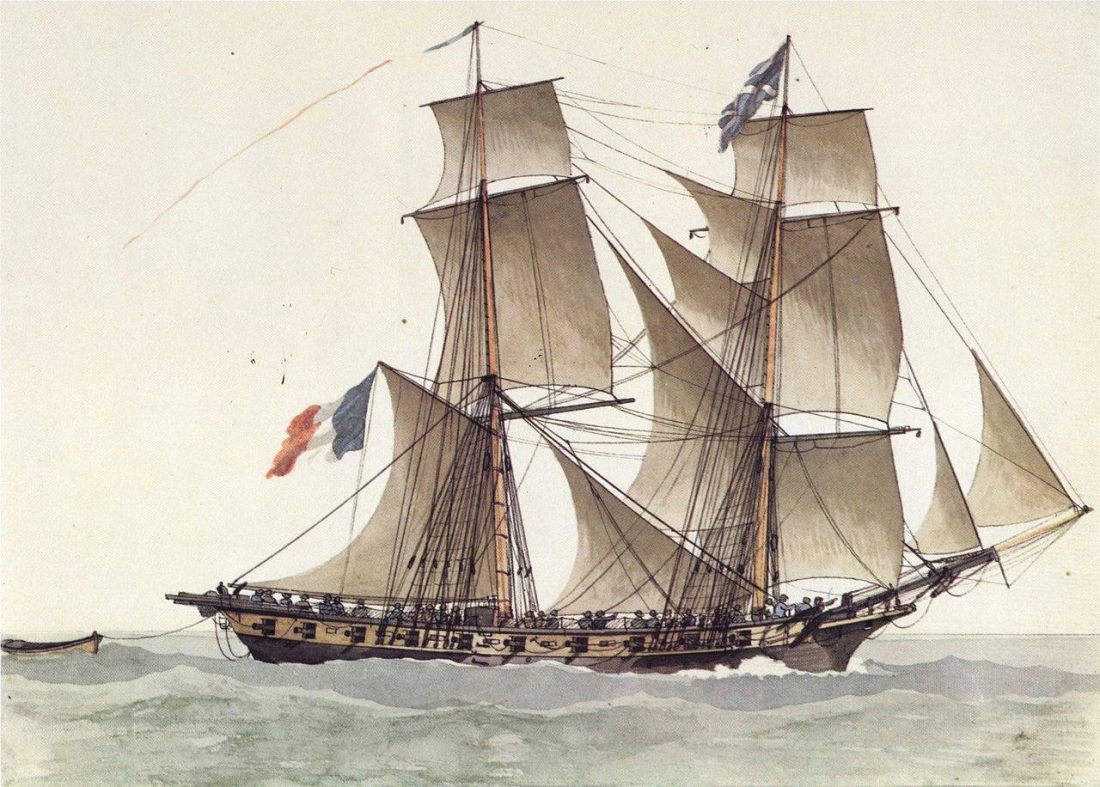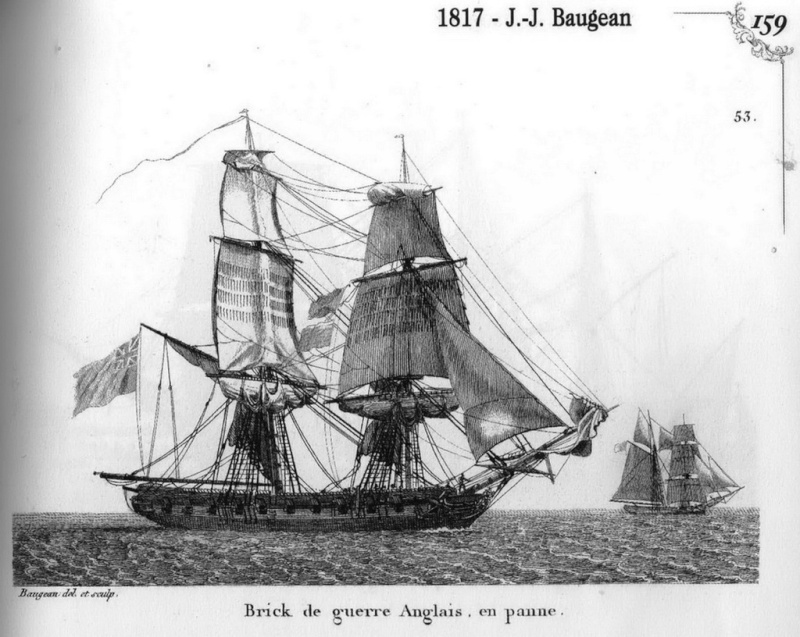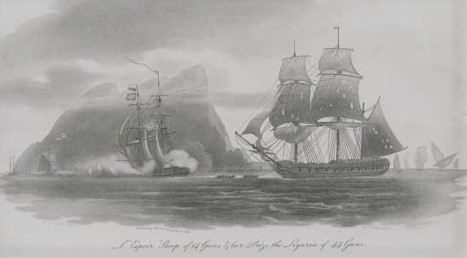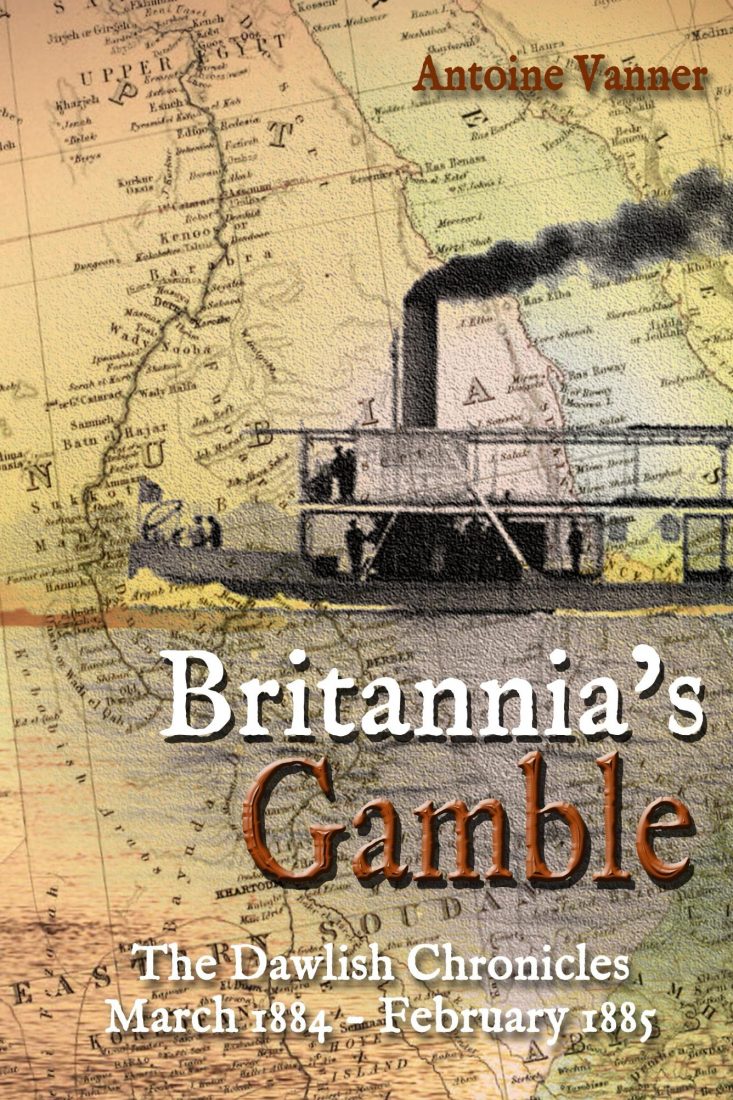Duel: HMS Espoir and the Liguria 1798
The Mediterranean was a very active theatre of naval warfare in 1798, culminating in Nelson’s spectacular destruction of the French fleet that had convoyed Bonaparte’s Army to Egypt at the Battle of the Nile on the 1st to the 3rd of August. At almost exactly the same time a much smaller action was being fought at the other end of the Mediterranean and, despite the difference of scale, involved no less bloody-minded determination to triumph. It was one of the classic “single-ship actions” of the era, in which two vessels went head to head and had to fight it out despite any support from other units. In this case an 18-gun brig recently captured from the French, HMS Espoir, was pitted against a much larger Genoese privateer bought from the Dutch, the Liguria.

French brig-of-war: Espoir would have looked generally similar (by Antoine Roux, 1765-1835)
The first, second and third-rate ships of the line represented the navy’s brute power and saw comparatively little combat – though when they did, as at the Nile, the result could be decisive. Their most important contribution otherwise was bottling up enemy fleets in their harbours. The frigates, beloved of naval novelists, were more glamorous – fast, powerfully armed and well suited to independent action, whether as commerce raiders or as scouts. Much of the vital but more mundane work was carried by the sloops and brigs, small craft that saw heavy use for convoy protection, a role as important in the Revolutionary and Napoleonic Wars era as was that of the corvettes and escort-frigates in WW2’s Battle of the Atlantic.
Though built in France, immediately before the Revolution, one of the six-ship Hasard class, HMS Espoir was little different to the dozens of such vessels already in Royal Navy Service. 92-ft long, and of 270 tons. She saw extensive service in the first years of the Revolution, when Britain and France were not yet at war, including a cruise off Newfoundland, carriage of despatches to Senegal in West Africa, a cruise south of Ireland and escorting of coastal convoys in the Bay of Biscay. Though lightly armed and manned initially, she was carrying twelve 6-pounder long-guns by 1794, when the Revolutionary War was gaining momentum at sea. Her crew was by then some 125 officers and men – the congestion in the living spaces must have been extreme. In September 1797, returning from Cayenne (French Guyana), she was captured by the frigate HMS Thalia.
Taken into British service, with no change of name, HMS Espoir was commissioned in June 1798 under Commander Loftus Otway Bland. She received two more 6-pounders – bringing her total to fourteen – and a crew of 80 officers and men.
 A Royal Navy brig – as seen in a French publication
A Royal Navy brig – as seen in a French publication
On the 7th of August, 1798, HMS Espoir was sailing near Gibraltar in charge of part of a convoy to Oran, when a large vessel, which appeared to be a man-of-war, was seen approaching with the apparent intention of cutting off some of the convoy. Despite the obvious superiority of the force he was facing, Bland determined to attack the stranger. This would prove to be the Genoese corvette Liguria. Bland later noted that she carried twelve 18-pounders, four 12-pounders ten 6-pounders and some sixteen small pieces, such as swivel weapons intended for sweeping decks clean of defenders. Massively outgunned, HMS Espoir was sailing towards an enemy with the capacity to blast her to a wreck with a single broadside. (One is reminded of the armed merchant-liner HMS Rawalpindi charging towards the battlecruisers Scharnhorst and Gneisenau in 1939 to save a convoy).
 Contemporary illustration of the action – note Gibraltar in the background
Contemporary illustration of the action – note Gibraltar in the background
On approaching within hail, around seven in the evening, an officer on board the Liguria ordered the commander of HMS Espoir to surrender, or he would sink his ship, enforcing the demand by one shot, and afterwards by a whole broadside. Gunnery training and discipline of the Liguria must have been abysmal, otherwise HMS Espoir would have been destroyed in the first minutes. The fire was returned in a spirited manner by the small British ship, and was kept up on both sides by the great guns and musketry for some three hours, when the captain of the Liguria hailed the Espoir, begging her captain not to fire any more. Captain Bland responded by telling him to lower his sails, and come on board. As no attention was paid to this demand, and as the Genoese appeared to be attempting some manoeuvre, Bland ordered another broadside, which the Liguria returned. HMS Espoir then tacked to fire her opposite broadside. The Genoese had had enough – and her captain was badly wounded, so she surrendered.
What is striking about this action – and about many like it – is that though the battle went on for hours, HMS Espoir’s losses were low: the master killed, and six men wounded. This emphasises how poorly trained and prepared the Liguria’s crew were, and how unsuited to combat with a much smaller warship with a well-drilled and disciplined crew.
 A xebec – as was HMS Espoir’s prize in 1799 (by Antoine Roux, 1765-1835)
A xebec – as was HMS Espoir’s prize in 1799 (by Antoine Roux, 1765-1835)
Bland was deservedly rewarded by promotion to coveted post-captain rank and, after further action in the following months, gave up command HMS Espoir to Commander James Sanders, whose exploits in her the following year included capture of a Spanish xebec, the Africa. By this stage HMS Espoir must have been in poor structural condition – Bland had warned about this when he left her. She returned to Britain in late 1799 and saw no further service before disposal in 1804. She had proved a most valuable acquisition.
Britannia’s Gamble
 This volume of the Dawlish Chronicles is set against the background of the murderous revolt in the Sudan by the Isis of its day, and which triggered one of the most dramatic campaigns that the British Army and the Royal Navy fought in the Victorian era. It’s available in paperback and Kindle, and subscribers to Kindle Unlimited and Prime can read at no extra charge
This volume of the Dawlish Chronicles is set against the background of the murderous revolt in the Sudan by the Isis of its day, and which triggered one of the most dramatic campaigns that the British Army and the Royal Navy fought in the Victorian era. It’s available in paperback and Kindle, and subscribers to Kindle Unlimited and Prime can read at no extra charge
Extract below from review by A. Belfrage in “Historical Novels Review” – November 2018
“Some authors have so researched their period that they seem to live the events, the surroundings, the details they describe. Antoine Vanner is one of these. He breathes such life into his narrative that you would think him a correspondent in the 1880s Sudan writing what he sees, rather than a man of today looking back . . . The opening chapter is a tour de force, leaving this reader emotionally exhausted after surviving nail-biting action when wave after wave of insurgents attack the British formations. After such an opening, an author has much to live up to, but Vanner does so with aplomb, guiding the reader through the political complexities of the time while generously lacing his narrative with period detail.
Captain Dawlish finds himself , commanding a desperate rescue operation that more than explains the title of the book. It is tense, gripping action at its best, enhanced by the sympathetic and introspective Nicholas Dawlish. Vanner does not shy away from the brutalities of war: some descriptions are so harrowing I had to take the odd moment before going on. But go on I must, desperate to know how this fantastic adventure would end.”
Click here, or on the cover image above, for more details of Britannia’s Gamble
The Dawlish Chronicles – now up to eleven volumes, and counting.
In paperback and Kindle – Kindle Unlimited subscribers read at no extra charge.
Click on the image below for further details of each book
Six free short stories are available for download to your Kindle. Access them by registering for the Dawlish Chronicles mailing list – just click on the banner below. You’ll be kept updated on new books and will receive other free stories at intervals.


